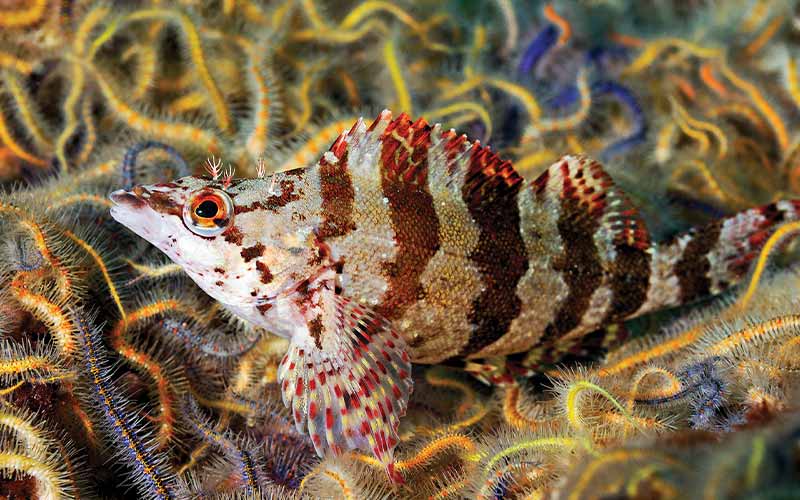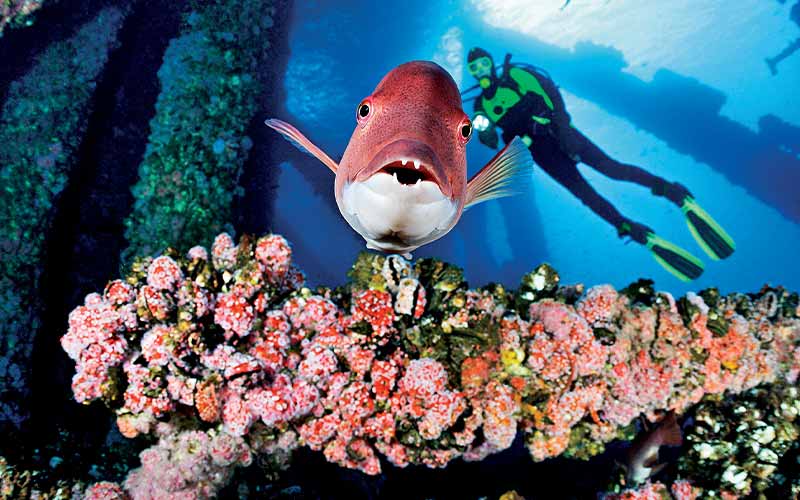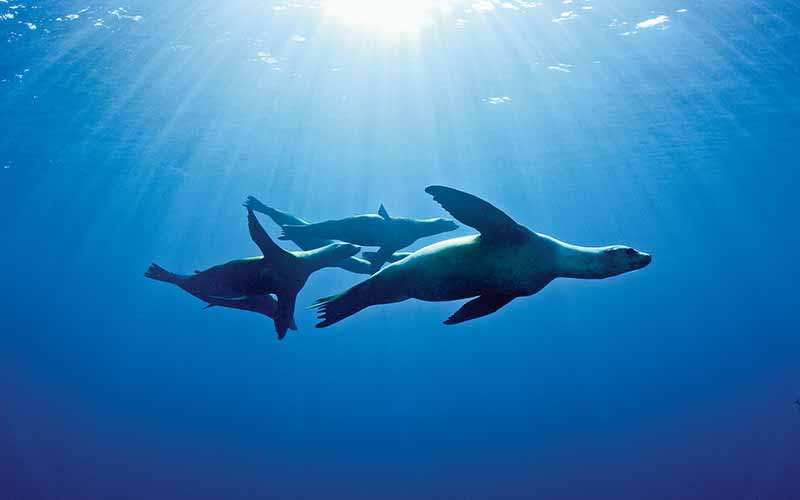Publisher’s Note: At the time Brandon Cole wrote this article about rig diving in California, there was certainly a greater prevailing sentiment that offshore oil rigs were a more benign environment than we have been forced to acknowledge, given the environmental catastrophe from the Deepwater Horizon rig in the Gulf of Mexico. The reality of the dive potential found on the specific oil rigs Brandon profiles remains valid, whatever sentiment one might have relative to the concept of offshore drilling. There is a yang to every yin, and the artificial reefs that a mature rig creates deserve the attention of the dive community — which is not to say any dive site is worth the havoc and destruction the Deepwater Horizon oil spill has unleashed on the Gulf of Mexico and beyond. —Stephen Frink
It’s a curious fact of Southern California diving that many experienced divers who’ve logged extensive bottom time in the Channel Islands have never explored the oil rigs found right off the coast. I’ve always wondered why. The rigs may be big, loud and ugly above the waterline, but down where it counts, their support structures are a near-perfect habitat for marine life.
Picture free-falling down a skyscraper painted in red, yellow and white anemones. Imagine following throngs of fish through a three-dimensional latticework of living reef, all the while trailed by an energetic troupe of sea lions. Such is the fun you can expect while flirting under the skirts of platforms Ellen and Elly.
Eight miles from Long Beach harbor, these twin platforms, joined at the hip, are but two of the more than 20 man-made structures astride the blue between Santa Barbara and Oceanside. With feminine names softening their industrial purpose, they have been transformed over the years into extraordinary artificial reefs and now represent some of the prettiest underwater scenery in California.
Shortly after submersion, I’m humming “Strawberry Fields Forever” into my regulator. A tentacled turf of Corynactis californica coats Ellen’s broad leg, rendering the red spectrum into a dozen shades. It’s gorgeous. Though the resplendent strawberry sea anemones are first to dazzle our wide eyes, upon closer inspection my buddy and I find crabs and small fish aplenty in the jumble of pink and purple, carmine and crimson. An even closer look reveals rock scallops and barnacles sheathed inside sponges, anemones and hydroids. Invertebrate competition for real estate is intense out here in the relatively barren midwater of the San Pedro Channel, and no part of the rig structure is left uninhabited.

We’ve planned a descent to 100 feet but nearly change our minds halfway down when in the span of a single breath the temperature drops sharply from 65°F to 57°F, with the visibility following suit, plummeting from 50 to 20 feet. (Thermoclines are no surprise to California divers, but that doesn’t mean you have to like them!) We continue, and at about 100 feet Ellen’s wardrobe changes to white. Ghostly plumose anemones, giants among their kind, sway back and forth. Although common much farther to the north, they are a rare sight for the SoCal diver. A freakishly large cabezon scowls at us, apparently none too pleased to see us in his murky realm. Even barraged by bubbles streaming up from other divers below (there’s still another 160 feet for techies to explore), he refuses to give up his cushy ambush spot. We take the hint and commence our ascent, tracing a zigzag path along crossbeams and diagonal supports up into the shallows.
For the day’s third dive we move southeast to platform Eureka, escorted along the way by a pod of common dolphins 100 strong. Geared up and eager to submerge, we await the word as the captain adroitly backs in close to the towering rig, then throws the engines into neutral. His “Dive, dive, dive!” sends us piling into water 700 feet deep. We surface swim to the nearest pillar, regroup and slip beneath the surface.

Once again, the transformation is startling. Above, Eureka is a bare metal skeleton, a work of cold, calculated engineering. Below, the rig is a showcase of the ocean’s artful craft. Shafts of sunlight lance downward to illuminate shimmering schools of fish, jack mackerel and blacksmith threading their collective way through the rig’s webbed framework.
Quick to steal the spotlight is a pack of California sea lions. Rocketing briefly onto the stage, they are whiskered, spiraling comets, banking and diving like fighter jets. Less showy perhaps but equally entertaining are the many sheephead that doggedly follow us about like lovesick puppies. Maybe they’re just lazy, hoping we’ll make life easy for them by cracking open scallops and serving ceviche. Regardless of their true intentions, there’s no denying that being stalked by these bucktoothed beggars for most of the dive provided us with some excellent photo ops. The calico bass and halfmoons, nowhere near as gregarious, are thereby summarily dismissed as we toodle around between 40 and 50 feet, admiring golden gorgonians, beds of rainbowed brittle stars and plump Pisaster sea stars patiently prying open supersized mussels. Impossible to ignore, however, is a fluorescent orange garibaldi. As cute and perky as Nemo, he launches upward from his nest and dares us to fin on by without taking a shot. We submit to its celebrity and gladly snap a few portraits.

Feeling the tug of a building current, we reluctantly move into the lee of the rig’s undercarriage and begin a leisurely ascent. Along the way we pause often to savor the unique experience of exploring the ocean’s very own jungle gym and to contemplate why more divers haven’t discovered this unique mixture of reef, wreck and blue-water diving.
How to Dive It

Diving the rigs requires special permission. It’s easiest to join a group on a permitted charter boat such as the Sundiver Express or Sea Bass. Anchoring is impractical due to depth, and tying off to a rig is prohibited. Therefore, live-boating is essential.
Conditions: Surge is common. Visibility can be 10 feet one day, 80 feet the next. Currents are ever-changing and can be strong, but it’s usually possible to find shelter behind pilings and girders. Both macro and wide-angle photo opportunities are excellent. Prime diving season is generally June through December.
Dive Profiles: The best marine life and most intense colors are found from the surface down to about 80 feet, though the rig structure goes much deeper. Technical divers can push 200-plus feet if they choose. Pay close attention to the divemaster and boat captain regarding safe procedures for entries, exits and underwater navigation. Navigation is primarily visual as your compass will likely be useless next to all that steel. Remember that these are working rigs. Be ever vigilant for crew boats coming and going.
Dive Operators: Divers can access platforms Eureka, Ellen and Elly via charter boats leaving San Pedro and Long Beach. See California Dive Boats.
© Alert Diver — Q3 Summer 2010